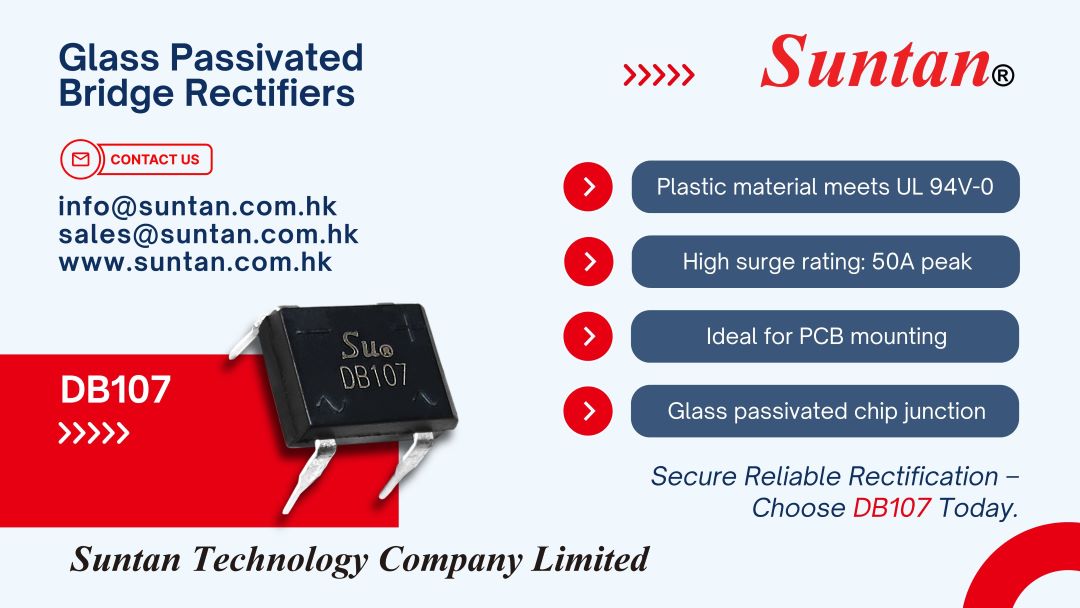
Stop Circuit Failures Before They Start – DB107 Bridge Rectifier with Verified Surge Resistance
Suntan Technology Company Limited
--- All Kinds of Capacitors
When selecting components for power electronics, engineers typically analyze voltage ratings, thermal limits, and dimensions—but frequently overlook surge-handling capability. Yet transient surges and inrush currents represent some of the most challenging stresses for bridge rectifiers, especially in high-density PCB applications.
Instead of focusing solely on general specs, this article guides you through practical design considerations and demonstrates why the Suntan DB107 bridge rectifier is an ideal choice to prevent hidden reliability risks in your circuits.
Understanding the Hidden Risks of Inrush Currents
At power-up or during transient events (like switching inductive loads), bridge rectifiers are subjected to instantaneous surge currents far exceeding steady-state ratings. If your rectifier isn’t selected properly, these inrush currents can:
• Create thermal hotspots on your PCB.
• Gradually weaken internal junctions, causing early failure.
• Trigger subtle yet damaging reverse leakage currents.
Because these issues may not cause immediate catastrophic failure, engineers often attribute eventual malfunctions to other system components. The true root cause—an inadequately rated rectifier—remains hidden until it’s too late.
Choosing the Right Bridge Rectifier: Key Criteria
Selecting the correct rectifier for reliable inrush handling is critical. Important considerations include:
• Surge Current Capability: Ensure your rectifier can handle peak transient currents as per JEDEC testing protocols.
• Thermal Stability:Look for components with glass-passivated junctions that remain stable over extended thermal cycling.
• Reverse Voltage Margins: Adequate reverse voltage ratings (e.g., 1000V or higher) provide essential margin against voltage spikes.
• Leakage Current: Minimal reverse leakage currents reduce hidden thermal load, preventing subtle damage over time.
• Packaging Quality: Flame retardant materials (such as UL 94V-0 rated epoxy) offer essential physical and electrical protection.
DB107: Real-World Tested for Surge Resistance and Reliability
The Suntan DB107 bridge rectifier isn’t just another commodity part. It has been specifically engineered and tested to ensure your designs remain stable under demanding surge conditions:
• Verified JEDEC Surge Testing: Certified to handle a 50A surge current, demonstrating exceptional robustness for compact designs.
• Glass-Passivated Junctions: Provides higher thermal conductivity and long-term electrical stability, minimizing failure risks.
• Optimized for High-Density Layouts: Weighing only 0.4g, DB107 helps meet strict PCB space constraints without compromising reliability.
• Wide Operating Temperature: Rated from –55°C to +150°C, ensuring reliable performance across extreme conditions.
Practical Applications & Selection Scenarios
Consider DB107 particularly beneficial if your design includes:
• LED Lighting Drivers: Protects LED circuits from line transients and ensures longevity.
• Switching Power Supplies: Handles inrush currents reliably, protecting downstream components.
• Compact Consumer Electronics: Small form-factor and robust design ideal for densely populated boards.
• Industrial Controllers: Stable rectification even under challenging electrical environments.
How to Know You’ve Chosen Correctly?
Ask yourself these critical selection questions when evaluating bridge rectifiers:
• Has this component been explicitly tested for realistic surge scenarios?
• Does the datasheet provide verified data, beyond just typical current ratings?
• Is the packaging designed to withstand thermal cycling and mechanical stresses typical in your application?
With Suntan’s DB107, the answer to all of these questions is a clear “yes”.
📧 Contact us:
info@suntan.com.hk
sales@suntan.com.hk


